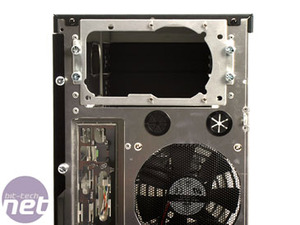
Testing my patience
The next stage in any case review we do is to test the chassis until the screws melt and collapses under the strain, forming a molten pile of mess which we then re-forge into official Bit-tech memorabilia which we sell at black market auctions in order to pay for the expensive lifestyle to which we have become accustomed.Unfortunately, the guys at Lian-Li were pretty clear that they wanted this case back when we were done, so we had to scale back our plans and settle instead for the normal barrage of tests. Spoilsports.
So, there are three things we’re looking for; good heat performance, low noise and a design which lets the system be installed and removed easily. Our ideal case is cool, quiet and fully automated – but failing that we’ll settle on a case that comes with all the required bits and which doesn’t take an eon to figure out.
To ensure a consistent set of results, we’re always make sure that we use the same system to test with. It’s a fairly simple system, but one which we chose because it should get nicely warm and will really tax the cooling system of any case we use.
Check out the system specs of our test ring below.
CPU: Intel Pentium XE 955 (dual-core, 3.46GHz)
Graphics Card: Sapphire Radeon X1600 XT Ultimate
Motherboard: MSI P6N SLI Platinum
RAM: 2x 512MB Corsair XMS2-667
Hard Drive: 1x 250GB Western Digital WD2500 7200RPM
Heatsink: Asus Silent Square Pro
So, the first question is ‘How easy was the system to install?’ Well, I’m going to lapse into a bit of controversy here and say that I was quite disappointed with accessibility of the Lian-Li. After all the office hype surrounding the Lian-Li brand I had expected the case to be much easier to use than it actually was.
My first problem was again with the screws for the motherboard as, even with the motherboard panel removed, the screws were hard to fit in and I could see the aluminium panel bending under the pressure of the screwdriver.
Moving on to the PSU installation, the four studs protruding from the rear are for the Lian Li PSU shroud. The PSU plate needed to be reversed so that the studs protruded outwards in order to install it correctly.
Hard drive installation was also a bit of a pain, as I mentioned above already, and it took a fair amount of time for us to figure out. The fact that we got annoyed having to add rubber grommets to the screws ourselves is a decent indicator of just how lazy we are. The fact that the HDD cables had to be funneled through the holes in the motherboard panel is also a bit of a pain.
Still, eventually we had the PC set-up correctly and it has to be said that anybody buying a new Lian-Li will most likely be more than willing to devote the time required to installing a system. After all, it’s not all about the system installation – with a Lian-Li it’s all about how sexy the case looks.
Anyway, let’s move on to the heat and noise testing and see if the B25 can hold up on those fronts, or if it’s destined to bomb like its namesake.

MSI MPG Velox 100R Chassis Review
October 14 2021 | 15:04












Want to comment? Please log in.